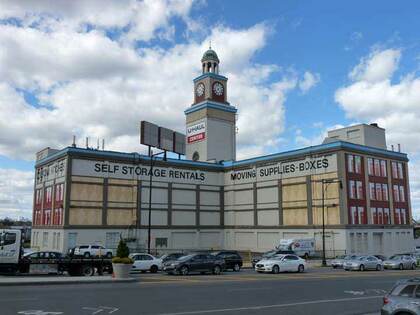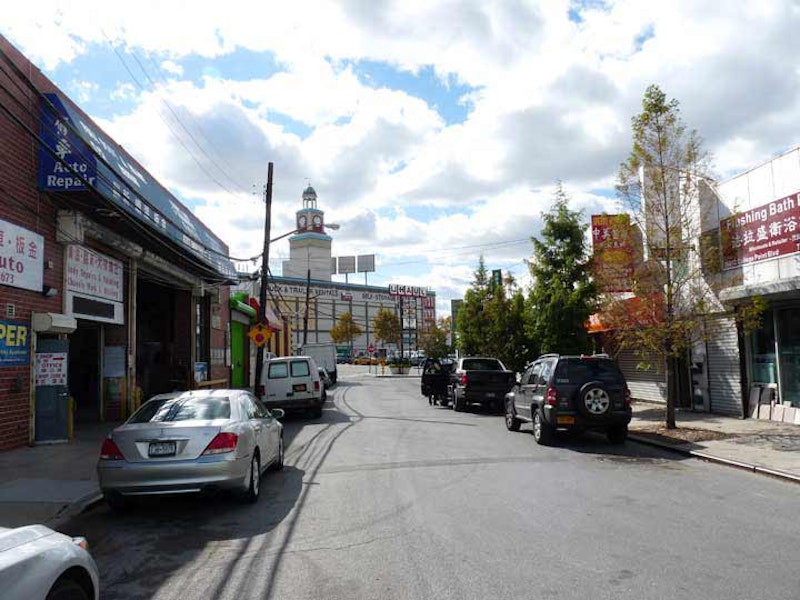Downtown Flushing is noisy, overcrowded, and smells horrible. That’s why I decided to take my latest voyage of discovery in Flushing during October, when the odor is tamped down just a little. I revisited some of Flushing’s labyrinthine jumble of streets—the neighborhood was first settled in the 1630s and many of the roads were built for horses and wagons, not automobiles—and see if there were any surprises there.
I was introduced to Flushing in 1969; I became a baseball fan that spring, at 11, and my team was the New York Mets, since Ron Swoboda had made an appearance at St. Anselm’s parish in Bay Ridge that preceding winter and I’d snagged his signature. It was a great year to become a baseball fan, since the Mets shocked the Cubs, the Braves, the Orioles and won the World Series. I thought they’d do that every year, but they’ve done it only once since then. I made frequent appearances at Shea Stadium that year, taking a very long ride from Bay Ridge on the RR train (trains had two letters then) and the 7. Now and then I’d look out over the center field fence at the Serval Zipper clock tower and Flushing beyond. The Zipper Tower, originally a furniture showroom building (see below) has outdated the zipper company and become a Flushing fixture.
The Dutch, led by New Netherland Governor William Kieft, took the region by force from the Indians and warred with them until the English arrived in 1645, on invitation from Kieft, who granted the English a vast 16,000-acre tract that included what’s now Flushing. The name is an English transliteration of the Dutch town of Vlissingen. Flushing, though, for most of its history was Dutch-dominated only because Peter Stuyvesant, Kieft’s successor, was its governor during its early history. The Brits named the town in honor of Vlissingen because the town harbored English refugees before they sailed for America.
King Rd., shown at the top, is an unusually angled two-block route running between College Point and Northern Boulevard. A look south provides a good look at the Zipper Tower, and if you’re lucky, you can also get a photo of a plane coming in for a landing at LaGuardia. Planes fly low over Flushing as they take off and land.
Why is King Rd. angled, though? The answer’s simple. Old maps show railroad tracks in the place where King Rd. would eventually be. The street was created after the Whitestone Branch of the Long Island Rail Road closed in 1932 for a perceived lack of business. The LIRR offered to sell the line to the city, which would’ve made it a part of the Flushing Line subway, the present #7. The city didn’t want to shell out for the line, which traveled north into College Point and then swing east to Whitestone. In the 1950s, though, the Transit Authority did purchase the LIRR section bridged over Jamaica Bay to the Rockaways, and that’s now part of the A train.
The Whitestone’s Flushing Bridge Street station was on Northern Blvd. just north of this location; Northern Blvd. was called Bridge St. as it went over the Flushing River, and Broadway east of that. As a legacy, though, we still have the Flushing Main Street station, so-called to differentiate it from Flushing Bridge Street—and the name has never been changed.

Generations of Mets fans going to games at Shea could see this clock tower over the left-center field fence, when it was the Serval Zipper factory. The building was built in the 1920s as the offices and factory for the W. & J. Sloane Furniture Company before it was a zipper factory. A couple of decades ago the zippers moved out and the building became a U-Haul service depot. Today, the hands on the clock have disappeared. I hope they’re replaced soon and the clock reactivated.

The Bowne House is here at Bowne St. and 37th Ave. as it has since 1661 when it was built by British settler John Bowne. Peter Stuyvesant, imposing a reign of terror against religious dissenters, had Bowne, a Quaker, arrested in 1662. Before the construction of the Friends Meetinghouse Bowne’s house was the primary site for Quaker services. Sentenced to pay a hefty fine, Bowne refused and was jailed; he was subsequently exiled to Holland.
While he was there, Stuyvesant’s bosses at the Dutch West India Company reversed Stuyvesant’s non-tolerant policy, claiming that the colony needed immigrants to ensure economic expansion, no matter what faith they were. Bowne returned to Flushing in 1664; the British sailed into New Netherland five months later, and Stuyvesant surrendered without a shot fired.

The first Flushing Freedom Trail, which was marked by a red line in the sidewalk and occasional small, red signs, was first proposed by Flushing High teacher and President of the Bowne House Historical Society Margaret Carman (1890-1976), a relative of Revolutionary War Captain “Lighthorse Harry” Lee and his son, Confederate General Robert E. Lee. Captain Lee described George Washington in an address to the Continental Congress in 1793: “First in war, first in peace and first in the hearts of his countrymen.”
Carman Green stands on triply historic territory. It borders both the Bowne House (the north side can be seen from the park) and also Kingsland Homestead, seen here, home to the Queens Historical Society but also a historic building in its own right, completed in Flushing in 1785. The green also stands on the site of Samuel Parsons’ plant nursery—Flushing’s history with the commercial plant industry began when William Prince established a commercial plant farm, or nursery, in western Flushing in 1737 along Flushing Bay. He first limited his business to apple, plum, pear and other fruit and flowering trees, and later expanded to shade and ornamental trees.
Other plant nurseries appeared in Flushing during the 1800s; one of the more successful was Samuel Parsons’, whose family gave Parsons Blvd. its name. Parsons brought the popular pink-flowered dogwood from Europe, as well as planted a weeping beech tree in 1847 on what’s now 37th Ave. that survived 150 years. Its descendants, grown from cuttings, are still there.

A roughly triangular monument, commemorating what were the Fox Oaks, stands across Bowne St. from Carman Green. Flushing’s history has always been closely intertwined with plants. The Quakers were no exception: a stone marker across Bowne St. from John’s house, worn into a rough pyramid by time, reads: “Here stood the Fox Oaks, beneath whose branches George Fox, founder of the Society of Friends, preached June 7, 1672.” Bowne St. is still crowned by oaks.
A meeting for Quakers and their supporters at John Bowne’s place attracted so many people that Fox held the meeting outdoors at a pair of oaks at what would be Bowne St. in a couple of centuries. The oaks remained in place until 1863 when they were knocked down by lightning. The Flushing Historical Society placed the marker in 1907; a much larger Quaker Meetinghouse, still standing on Northern Blvd., was opened in 1699.

Pressing west on 37th Ave., Citi Field, the New York Mets’ third home field (after the Polo Grounds in Sugar Hill, Manhattan and Shea Stadium) comes into view. The park opened in April 2009 and in 2015 hosted its first playoffs and World Series. The Mets have always been referred to as playing in Flushing, but Citi Field (and Shea Stadium) were west of the Flushing River, hence technically in Corona. Both parks were and are at the northern end of Flushing Meadows-Corona Park, but originally the Flushing Meadows spread out on either side of Flushing Creek, until it was industrialized and turned into a “river”—technically it’s a creek.

Here’s a building I know nothing about but am curious. It’s a lengthy, rectangular-shaped building that takes up almost the entire block between Northern Blvd., King Rd., Prince St. and 36th Ave,, it’s made of brick and has Dutch-style stepped gables and a central bell tower (the bell is still in place). Most mysteriously, the building, which is home to a bait and tackle shop and a church among other things, says “Peter Haff Huis” on the central entrance, “huis” Dutch for home. I’d have to say this was a restaurant or roadhouse along Northern Blvd. that would greet travelers after they had crossed the Flushing River Bridge, which has gone through much smaller iterations before the monster bridge of today. According to historian Jason Antos, Peter Haff was an early Dutch settler who built his home in Flushing around 1643 to 1645.
—Kevin Walsh is the webmaster of the award-winning website Forgotten NY, and the author of the books Forgotten New York (HarperCollins, 2006) and also, with the Greater Astoria Historical Society, Forgotten Queens (Arcadia, 2013)

